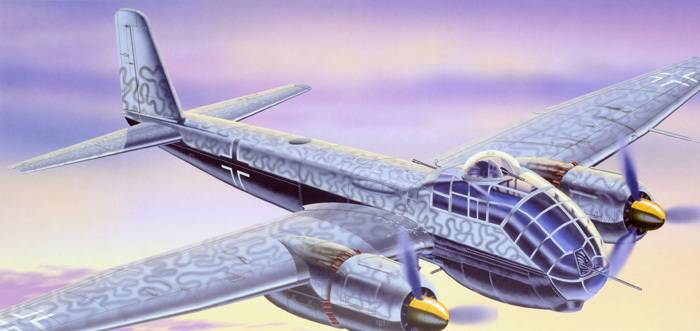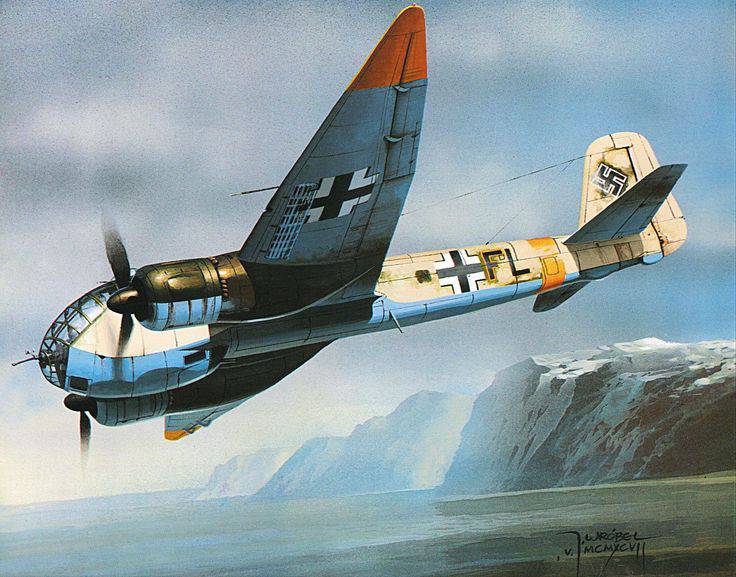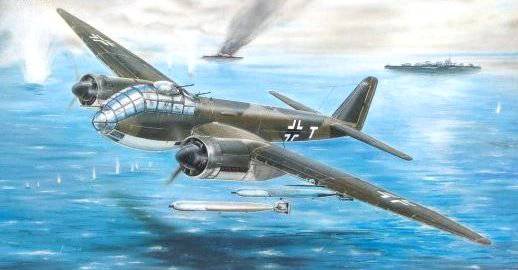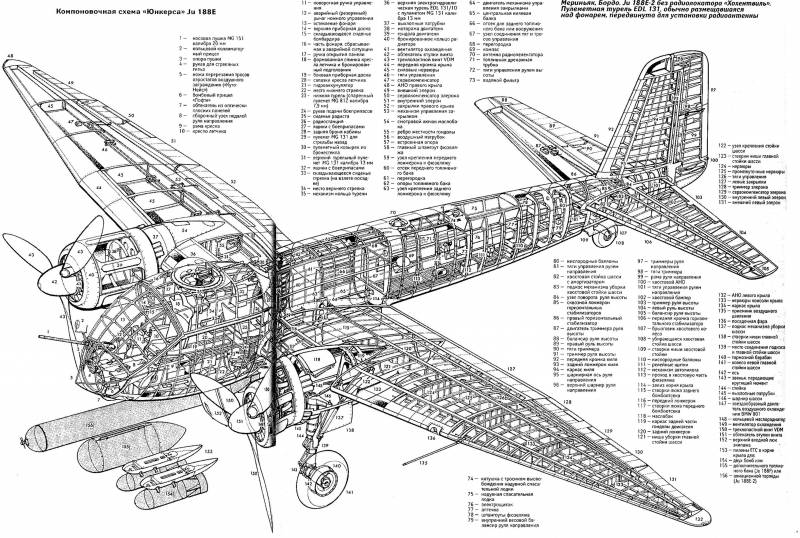Ju-188: long road to the sky. Part I
Among other things, the success of the Junkers application for a qualitatively new type of bomber, the main feature of which should be high speed, received particular success. This was the concern’s response to the so-called Schnellbomber A project. This German company put out at once two variants of combat vehicles of a very wide range of applications: the two-kilowat Ju-85 and the one-kilo Ju-88, of which the latter became the prototype of the most common German front-line bomber. However, due to the need to take into account in the design many often mutually exclusive requirements, the serial Ju-88 in 1939-1940. proved not particularly good during the fighting. At the same time, the overall design of the aircraft turned out to be successful: it not only allowed the Ju-88 to be finalized without any problems, making it the most effective and most large-scale German bomber of the middle of World War II, but also turned out to have a very deep design basis for the future.

This became clear during the work of the aircraft concern “Junkers AG” on another project - Schnellbomber B, whose goal was to develop the concept of a second-generation speed twin-engine bomber that would not create a critical load on the Reich industry, but would be roughly comparable to the bomb load with 4-motorized bombers of the USA, Great Britain and the USSR. The main emphasis in the development of this program was placed on an ideal aerodynamic form, which, in combination with powerful engines, would allow developing a very high speed for a bomber of that era with a very large bomb load. This fighting machine, according to the Nazi leadership, was to be the basis of the German bomber aircraft in the 1940-s and used to wage a limited war in Europe that does not require long-range bombers. It was the air fleet “Schnellbombers of type B” that had to become the basis of the Reich bomber aircraft during the 1940-s before the transition to the turbojet aircraft (the fleet of which, according to the pre-war calculations of the German leadership, it was planned to create, in turn, at the end of 1940 - early 1950- ies).
According to the competition requirements of ReichsLuftfahrtMinisterium (RLM - Ministry of Aviation of the Third Reich) from 1939, Schnellbomer B had to reach a speed of at least 550-600 km / h with a bomb load of 3000-4000 kg (ideally - 650 km / h with a bomb load in 6000 kg) and have a range that allows you to perform return missions from the territory of Germany at least to the territory of Great Britain (possibly without Scotland and Ireland). The Junkers concern’s response to these requirements was again two projects: a certain intermediate variant, named “1-88 model” and which was essentially a deep modernization of Ju-88, and a qualitatively new machine - “2-88 model”. However, if the overall design of both variants was generally ready at the end of the 1941 of the year, the German engineers could not create the necessary engines with high efficiency and a good level of reliability until the 1942 of the year. Also, without a doubt, A. Hitler’s decision, made by him at the end of 1940, had an effect on the delay in commissioning this aircraft: to suspend the development of new types of weapons that cannot be commercialized during the year.
As a result, when it became clear to the German leadership (especially after Stalingrad and Tunisia) that the strategic situation was not at all in favor of the Reich, and the Allied air force was sharply increasing both quantitatively and qualitatively, and the Luftwaffe began to lose the ability to conduct bombing missions urgently launch into the series at least a “compromise” version of the Ju-188, which did not require a radical restructuring of production and made it possible to maintain a high level of production of the Ju-88 (which became the main strike aircraft of the stskih Air Force).
Thus, in October 1942, the program for the completion of the Ju-288 was slowed down, and all forces were devoted to the urgent introduction into mass production of the Ju-188. The process was successful, and in January 1943 a second prototype of the project was built - Ju-188V2, called “Racher” (“Avenger”). The name was due to the fact that the creation fleet of these aircraft was planned primarily as a response to the ever-increasing British nightly bombing raids against German industrial centers. It is worth noting that one of the important features of this aircraft was the versatility of the mounting structures of wing gondolas for engines and general balancing. Thanks to this, both BMW-801 engines and Jumo-213 engines could be installed on a single glider, which made it possible to increase output almost regardless of the degree of readiness and the level of supply of engines. But, despite some measures taken, Ju-188 production grew very slowly: in February – April 1943 it did not exceed 2 cars a week. Only after the introduction of the program for the total mobilization of industry did this total production of aircraft of this type reached 1943 units by the end of 283 (including 174 units in the version of a bomber and torpedo bomber (“torpedobomber”) and 109 units in the version of high-altitude and all-weather reconnaissance).

But this number looked ridiculous when compared with the production of bombers in the anti-Hitler coalition allies. The Nazi leadership also understood this very well and demanded an even higher production rate, which was finally possible: in 1944, 918 Ju-188 was already produced (including 434 units in the bomber and torpedo bombers version and 484 units in the reconnaissance variant ), primarily due to the opening of assembly plants at the ATG plants in Leipzig and Siebel in Halle. However, then other factors began to play against the Nazi industry - in particular, in the summer of 1944, a number of Junkers factories suffered in Halle, Aschersleben, Halberstadt, Magdeburg, Yuteborg, etc., as a result of a series of strikes by the bomber aircraft of the Western alliance. .), including the assembly line Ju-188. In addition, since the fall of 1944, due to the air raids of the Anglo-Saxon Air Force, a traffic collapse on the Reich railways, a shortage of supplies of strategic raw materials and especially fuel began to affect. All this forced the leadership of Germany to decide on the curtailment of production of this fairly efficient and difficult to bring down aircraft, with the result that in January-February 1945 of the whole Ju-33 X-unit of the modified reconnaissance unit was manufactured.
Thus, out of a total of one hundred eighty eighths in 1234 units (601 at Junkers AG, 244 at Siebel, and 211 at ATG), 125 aircraft were destroyed during production, and from 1109 machines taken by the “Flugzeuge durch die Bauaufsichtsleitung” (BAL - Control Commission of the Ministry of Aviation), the entire 874 of the aircraft hit the front units. The remaining 235 units. were destroyed (mainly due to raids by the Western air force, and partly due to poor logistics or guerrilla actions of the European anti-fascist underground) during railway transportation, on the ground at factory-based bases and piloting by novice pilots during training. In addition, several dozen cars were handed over to the allied countries of Germany (in particular, in the Hungarian Air Force and, apparently, to the fascist Air Force of the Italian Republic of Salo and the Croatian Air Force, where the Ustashi regime was in power).
Being a deep revision of the Ju-88, in terms of design, of course, the Ju-188 largely retained the features of the forerunner, differing from that in the first place in the shape of the cabin. A new form and a different type of glazing made it possible to improve visibility and greatly reduce aerodynamic drag. The design of the Ju-188 wing also underwent significant changes: its scope was increased, and it received characteristic sharp tips. Also, not only due to new engines, but also because of the improvement of aerodynamics, the German designers managed to achieve a rather significant increase in flight speed with a much larger bomb load than the Ju-88. The defensive armament was also qualitatively different: the X-NUMX-mm MG-188 gun was mounted in the nose of the Ju-20 fuselage; from attacks from above on either side of the plane was protected by an 151-mm MG-13 machine gun in a flat transparent turret rotating on 131 °; there was a firing point with a coaxial 360-mm MG-7,9 machine gun from attacks from below; for the additional defense of the tail zone, another MG-81 machine gun was sometimes installed.
In general, as already noted, the mass production of Ju-188 for a number of reasons took a very long time to develop and did not reach large levels. Therefore, it proceeded in parallel with the already well-established large-scale production of Ju-88 (which became the basis of the Luftwaffe bomber formations in 1943-1944, the total production of various types of which amounted to more than 15000 units). Some researchers believe that such a decision was erroneous for the Reich, so that the release of a more advanced bomber was inhibited (this indicates that, of course, a delay of about a year in a more fatal nature was a type of bomber and the annual delay in deploying its large-scale production). Other researchers believe that this decision of the Nazis was quite reasonable, because input to the large Ju-188 series would still be long, and the transfer of a number of Junkers AG production facilities to the release of a new, but still not having absolute advantages model would inevitably entail a significant, albeit temporary, reduction in the supply of Ju-88. But anyway, thanks to this parallel production, successful technical developments created for one aircraft were introduced on the other, and vice versa, and the use of many universal parts in the design of both models also reduced the dependence of production on the supply of specialized components.
As well as his “older brother” Ju-88, the Ju-188 turned out to be a very versatile machine and was mass-produced in versions of a high-speed bomber, a torpedo bomber, and a high-speed long-range reconnaissance aircraft. Modifications Ju-188 A-1 and A-2 were the first bombers. At the end of the 1943 of the year, the Ju-188 C-1 had, with reduced speed data, stronger defensive armament (2х20mm guns and 4x13 mm machine gun) and increased bomb load (3000 kg). Ju-188 E-1 became an alternative serial bomber modification with BMW-801ML engines (1600 hp) due to the catastrophic shortage of more advanced Jumo-213 engines (2240 hp). Later, the Ju-188 G appeared, the bombing load of which reached 3500 kg. However, in general, we can say that as a bomber, this aircraft did not have a large qualitative superiority over the Ju-88. During the daytime bomber missions, the squadron Ju-188 still suffered heavy losses, because the maximum speed with a bomb load prevented them from escaping attacks not only from the latest Western allies fighters (such as Spitfair Mk-XIV, P-51 D Mustang and Tempest Mk.V), but also from the 1942- 43 The situation on the Soviet-German front was somewhat different, but first of all this aircraft was created for action on the Western front, and therefore the results of combat use there were particularly important for the Luftwaffe.

Quite effectively, Ju-188 has proved itself in the role of a sea torpedo bomber. Thus, the main production version of this modification, the Ju-188 A-3, could lift as many as two torpedoes LT-1 (b) or F-5 (b), placed at the bases of the wings, which was a relative rarity in aircraft of a comparable class. On the Ju-188 E-2 variant, the navigation equipment was further improved and the FuG-200 radar was installed, which made it possible to search for ships in bad weather and at night, which allowed aircraft of this modification to successfully avoid enemy day fighter attacks (although, of course, from - due to the imperfection of the equipment of that time, the problem of reaching the target was quite acute).
However, probably the most advanced in the Ju-188 lineup were reconnaissance options. The Ju-188 D-1 was the same Ju-188A, but with Rb 50 / 30, Rb 70 / 30 and NRb 40 / 25 automatic cameras installed at various viewing levels. In addition to this, the Ju-188 D-2 model received the FuG-200 radar and improved navigation equipment, which allowed to fly to reconnaissance at the end of the night so that, with the first rays of dawn, it was already above the front line, and also to reconnoiter over the sea (zielfinder - “target designator”) for shock groups. The modification Ju-188 F, created in 1944 year, received more high-altitude engines BMW-801 G-2 (1700 hp), so that the maximum airspeed of this type of machine at an altitude of 6200 meters reached 600 km / h at a distance of 3400 km
The Ju-188 S-1 modification, which had no weapons, was classified as qualitatively different, but was classified by the Germans as an “high-altitude invasion attack aircraft”, since thanks to redesigned engines with a special forcing GM-1 with a relatively small bomb load in 600-800 kg (small, by the standards of the Luftwaffe; for example, by Soviet standards, the normal bomb load of the main front-line bomber Pe-2 was 600 kg, when overloaded 800 1000 kg it could reach speeds up to 685 km / h with a ceiling height of 11.500 m). So the Luftwaffe had a plane that even in the summer and autumn of 1944 of the year, under conditions of absolute domination of the allies in the sky, was able to carry out not only nightly, but even with some luck and daytime bombing, not to mention the excellent capabilities of the scout.
The Ju-188 T variant, which could develop (thanks to Jumo 213 E-1 motors (2020 hp)) maximum speed over 700 km / h at an altitude of 9500 m, i.e. Even without having defensive weapons, it was virtually inaccessible for most of the piston fighters of the countries of the anti-Hitler coalition to intercept.This seemingly fantastic speed for a WWII piston bomber made vehicles of this type really universal "invasion planes" that even without an escort and without armament, it was perfectly possible to carry out daytime bomber missions, and indeed, the aircraft of this modification were rightly classified by the Germans as Höhenaufrlärer (in English, the same term Intruder) and were intended to carry out “demonstrative” daytime bombing as positions of Allied forces at the front , and for strikes against targets far beyond the front line (for example, cities in the territory of the same England). But since the end of 1944, the Reich industry has more and more plunged into a state of collapse. Fortunately for the Allies, the Germans were able to produce only 80 machines of the Ju-88 T variant.
So, we got acquainted with the features of the creation of this little-known aircraft, and in the next part we will consider the features of its further development and combat use.

Information